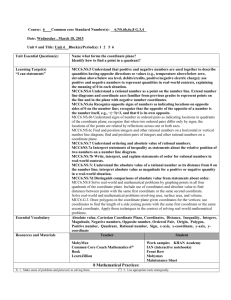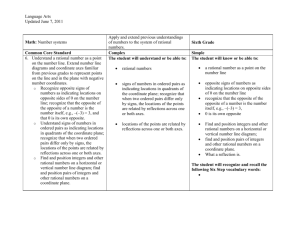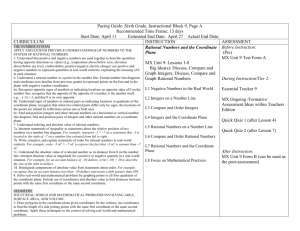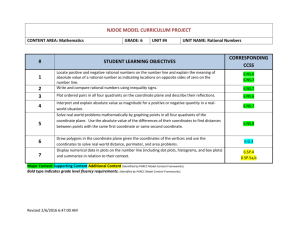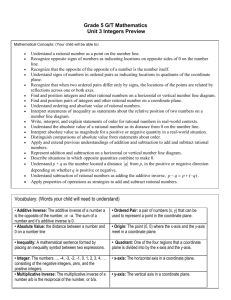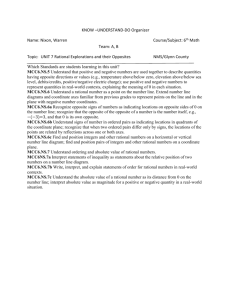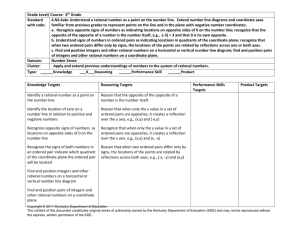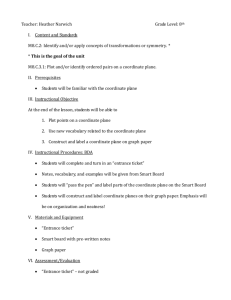LFS Unit 1: Rational Explorations: Numbers and their Opposites
advertisement
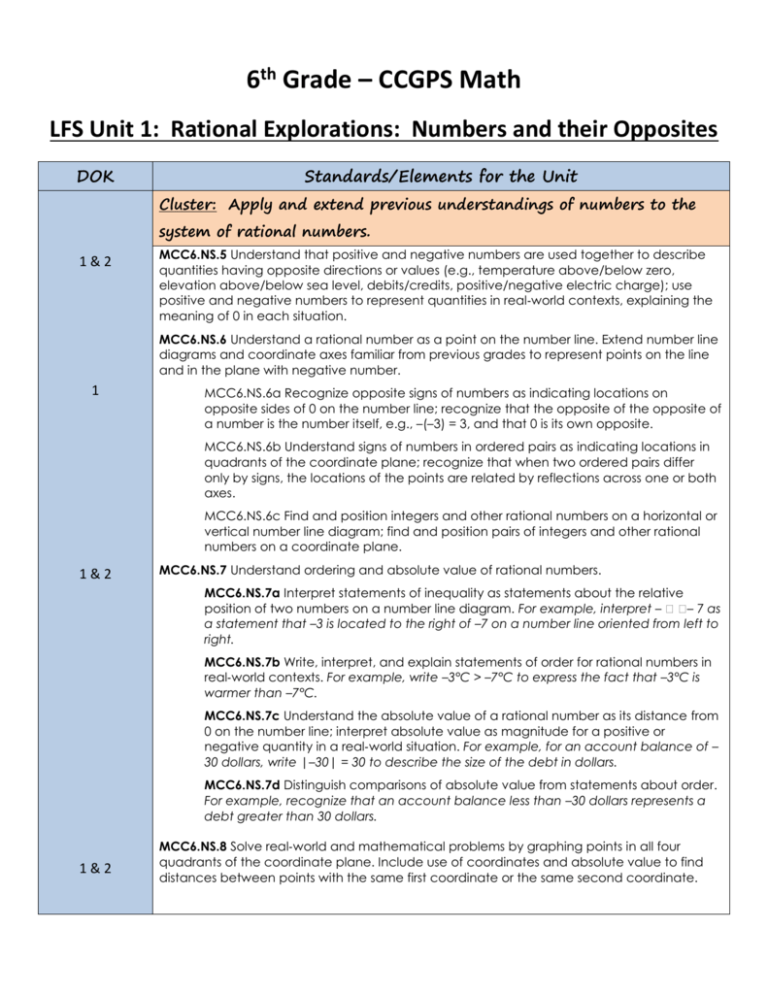
6th Grade – CCGPS Math LFS Unit 1: Rational Explorations: Numbers and their Opposites DOK Standards/Elements for the Unit Cluster: Apply and extend previous understandings of numbers to the system of rational numbers. 1&2 MCC6.NS.5 Understand that positive and negative numbers are used together to describe quantities having opposite directions or values (e.g., temperature above/below zero, elevation above/below sea level, debits/credits, positive/negative electric charge); use positive and negative numbers to represent quantities in real‐world contexts, explaining the meaning of 0 in each situation. MCC6.NS.6 Understand a rational number as a point on the number line. Extend number line diagrams and coordinate axes familiar from previous grades to represent points on the line and in the plane with negative number. 1 MCC6.NS.6a Recognize opposite signs of numbers as indicating locations on opposite sides of 0 on the number line; recognize that the opposite of the opposite of a number is the number itself, e.g., –(–3) = 3, and that 0 is its own opposite. MCC6.NS.6b Understand signs of numbers in ordered pairs as indicating locations in quadrants of the coordinate plane; recognize that when two ordered pairs differ only by signs, the locations of the points are related by reflections across one or both axes. MCC6.NS.6c Find and position integers and other rational numbers on a horizontal or vertical number line diagram; find and position pairs of integers and other rational numbers on a coordinate plane. 1&2 MCC6.NS.7 Understand ordering and absolute value of rational numbers. MCC6.NS.7a Interpret statements of inequality as statements about the relative position of two numbers on a number line diagram. For example, interpret – � �– 7 as a statement that –3 is located to the right of –7 on a number line oriented from left to right. MCC6.NS.7b Write, interpret, and explain statements of order for rational numbers in real‐world contexts. For example, write –3°C > –7°C to express the fact that –3°C is warmer than –7°C. MCC6.NS.7c Understand the absolute value of a rational number as its distance from 0 on the number line; interpret absolute value as magnitude for a positive or negative quantity in a real‐world situation. For example, for an account balance of – 30 dollars, write |–30| = 30 to describe the size of the debt in dollars. MCC6.NS.7d Distinguish comparisons of absolute value from statements about order. For example, recognize that an account balance less than –30 dollars represents a debt greater than 30 dollars. 1&2 MCC6.NS.8 Solve real‐world and mathematical problems by graphing points in all four quadrants of the coordinate plane. Include use of coordinates and absolute value to find distances between points with the same first coordinate or the same second coordinate. Student Learning Map Unit 1: Rational Explorations – Numbers & Their Opposites Key Learning To understand and compare rational numbers and their opposites and apply that knowledge to mathematical and real world problems. Unit EQ How do I apply the properties of rational numbers to real world context? Concept Concept Concept Rational numbers and the application of rational numbers (NS.5, NS.6a, NS.7a, NS.7b) Navigating & plotting the coordinate plane (NS.6b, NS.6c) Absolute value & the coordinate plane and the application of absolute value & the coordinate plane. (NS.7c, NS.7d, 8) Lesson EQ’s Lesson EQ’s Lesson EQ’s 1. When are negative numbers used? 2. Why are negative numbers important? 3. How would you explain the value of an opposite number? 4. What is the opposite of zero (0)? 5. Why is position important to a number line? 6. How do statements of inequality help me place numbers on the number line? 7. How do negative and positive numbers represent quantities in real world context? 8. How do you write, interpret and explain real world context using inequality? 1. How do we position rational numbers on a vertical number line? 2. How do you use the signs of a coordinate pair to determine location on the coordinate plane? 3. Why do the coordinates of a reflection differ? 4. How do you use the signs of a coordinate pair to determine a reflection? 5. How do we plot coordinates on a coordinate plane? 6. How do we locate coordinates on a coordinate plane? 1. How do we find the absolute value of a number? 2. How do we apply absolute value to a real world situation? 3. How do we order the absolute value of rational numbers? 4. How can we find the distance between two points on a coordinate plane? 5. How do you use absolute value and coordinates to find length of a polygon on a coordinate plane? Vocabulary Vocabulary Vocabulary Required Vocabulary: magnitude, rational number, integer, zero, positive, negative, opposite, number line, inequality, greater than, >, less than, < Suggested Vocabulary: gain, loss, increase, decrease, debt, profit, credit, debit, altitude, defend Vertical; horizontal; x-axis; y-axis, xcoordinate, y-coordinate, coordinate pair, origin, quadrant, coordinate plane, reflection, Evaluate; perpendicular; polygon; absolute value; distance, length, vertex/vertices 6th Grade – CCGPS Math LFS Unit 1: Rational Explorations: Numbers and their Opposites

